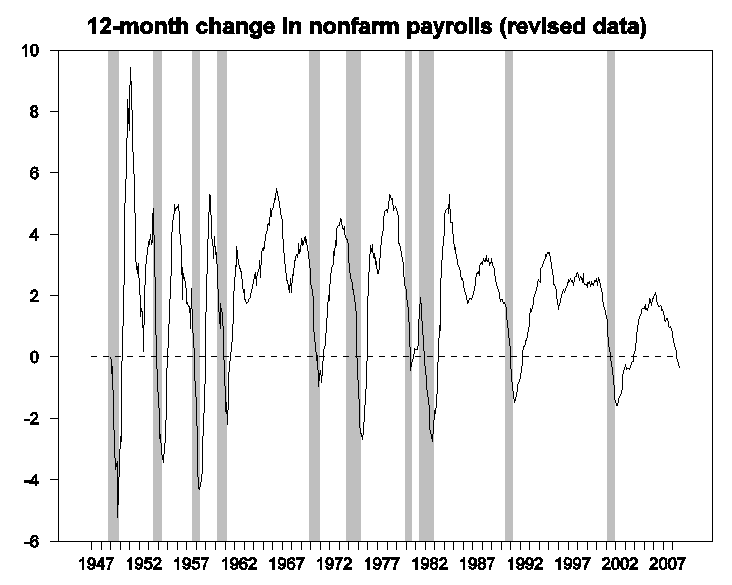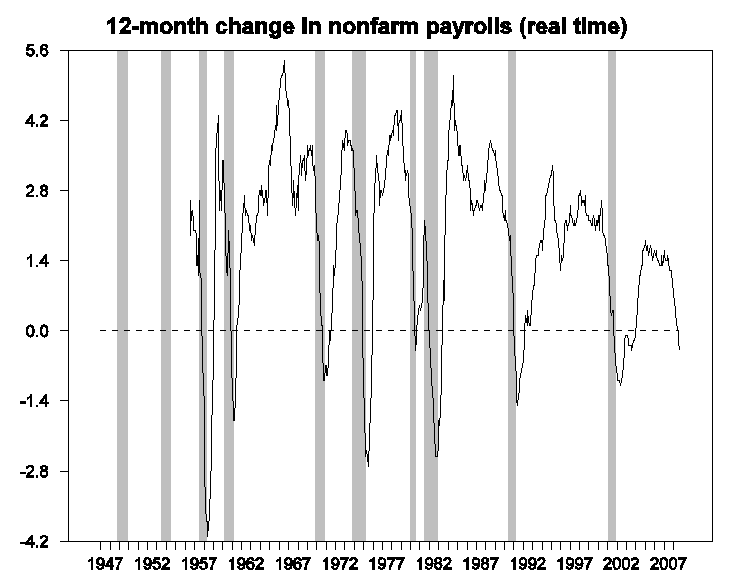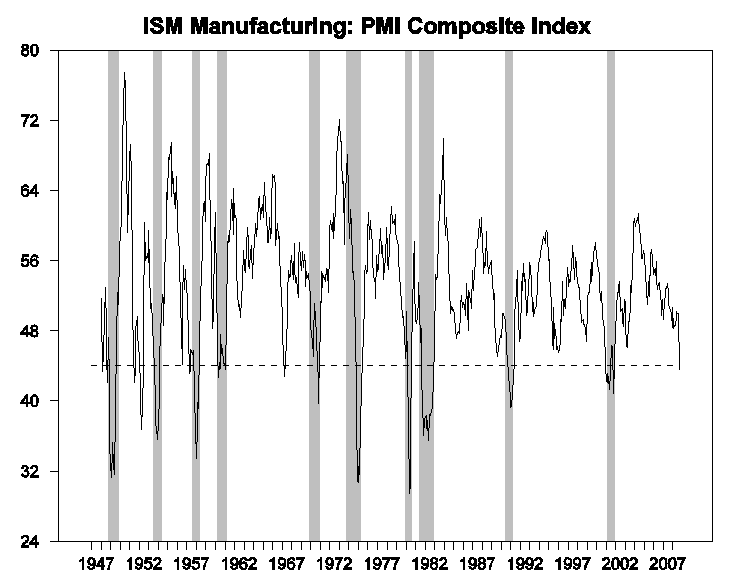UCLA Professor Ed Leamer recently proposed four criteria for determining whether the economy is in recession, and concluded at the time of his study (two months ago) that the U.S. had not yet crossed that threshold. But this week’s data might cause him to change his mind.
Professor Leamer observed that recessions are usually characterized by a 6-month drop in civilian employment of more than 0.4% as measured by the BLS household survey. At the time he wrote his paper, the U.S. fell just short of that standard. But the BLS reported on Friday that this measure fell by 222,000 jobs in September, putting the 6-month change at -0.5%. On the basis of this number, Leamer would now have to change his call.

|
Leamer further suggested that a 6-month change in the unemployment rate of more than 0.8 percentage points also signals a recession. Although the BLS reported on Friday that the unemployment rate held steady in September at 6.1%, the sharp increase during July and August had already shot us well past Leamer’s threshold for a recession.

|
Leamer also noted that it’s typically called a recession if the 6-month growth rate of nonfarm payroll employment falls below -0.5%. September’s NFP drop of 159,000 workers leaves us just short of that cutoff, with the 6-month change standing at -0.4%. Feel better now?

|
I don’t. I prefer to look at whether the 12-month growth rate is negative, as it has now clearly become.

|
Since the employment numbers are subject to lots of revision, it’s worth noting that calling a recession when there is a 12-month drop in NFP looks pretty reliable if one bases it on data as they are actually released at the time, rather than plotting the historically revised data as was done in the previous diagram.

|
Finally, Leamer observed that in a recession, the 6-month growth in industrial production falls below -3%. The latest value, -1.7%, still remains a bit shy of that threshold

|
Though once again, if you look instead for a drop in industrial production over a 12-month interval, we’ve now seen that.

|
While we’re reviewing the week’s cheerful news, I should also mention the ISM index. This is based on the Institute of Supply Management’s survey of manufacturers. A value below 50 indicates that more companies are reporting deterioration than are reporting improvement in categories such as new orders, production, and employment. September’s reading for this index of 43.5 looks pretty recessionary.

|
The one indicator that’s still holding up is GDP. However, I noted last week that much of the apparent growth in GDP over the last three quarters can be attributed to the statistical discrepancy between income and production data. In any case, we’re going to get a new GDP number at the end of this month, and I don’t expect it to be pretty.
Technorati Tags: employment,
recession probability,
recession indicator index,
macroeconomics,
economics
Dr. Hamilton or any one:
sorry to repeat this comment, but it looks more apt in this post/article.
if anyone can point me to any other blogs where i can get my answers, that will be helpful.
—————
i have been reading everywhere that now we are heading towards a great depression and not much can be done to make the pain less.
by great depressions, people are predicting that unemployment(official) will shoot up as much as 10-20%.
housing will fall another 30%(panic sales and foreclosures) and will stay there for 4-5 years.
businesses are going to now start laying off preparing for a long recession and consumers are already maxed out and scared hence they will pull back sharply, sending the consumption on a cliff dive.
stock market will go down further 10-20%, destroying wealth and bringing more angst to consumers.
but i feel that if the government wanted it can definitely lessen the pain by doing the below:
1. backstop housing by buying and removing from market all default/foreclosure property(will the current bailout plan do it?)
2. FED interest rate lowered to 0.5%, and mortgage interest lowered to 5%(fannie and freddie are gov entities and can loan money infinitely)
3.more benefits given to home buyers to help housing(how about increasing the short term tax break from 7500 to 25000, which can also be financed from IRA or 401k with no penalty)
3.stimulus checks every three months to help consumer income
4.Faciliate interbank lending by being the middle man(use the trust of the government).
5. Massive infrastructure projects to support job.
in other words…fight deflation and debt with inflation to stave off the sharp pain.
i think these are doable….but will they do it?
people may ask where will they get the money for all this, if i am not wrong government can still borrow at less than 5%, and if FED rate is lowered and we go into recession people will be happy to loan the government at less than 4%.
since price of food and energy is going down, there is no more worry that more money into the system will cause inflation.
right now money is getting destroyed faster than FED can inject money into the system.
High home prices shouldn’t be a government goal any more than high food prices should be a government goal.
Me neither: the only thing that might hold up relatively well could be export growth (but we`ve just the July trade balance datapoint). And in the fourth quarter the shipments abroad should slow down further.
I agree that high home prices should not be supported…but that does not mean they can let a long recession happen because of that.
what is the point of cheap homes…if people dont have a job to buy them?
The point of cheaper homes – and cheaper homes – is that those who have been responsible and those coming into the entry level economy out of college, etc. will be able to afford them.
Once they’ve dropped another X%…
As JDH proves above there is little doubt the domestic US economy is in recession.
The big unknown, this quarter as last, in terms of GDP growth, is the impact of import reduction and export expansion. Notwithstanding the slowing in the rate of export expansion, they are still expanding, whereas imports are slowing very fast, this will certainly have a strong impact on any GDP figures, this quarter as last.
Fundamentally the cause of the recession is that the real estate bubble has caused mis-allocation of resources for a number of years. For example, you want to put people back to work. What about the home construction industry? Are we going to continue to build houses that people don’t need? The bubble made us do too much of that already! Likewise for home improvements, which have been bulked up by people “flipping” homes (buying them for quick resale). Demand in those areas has to fall. And people can’t just switch over to new work instantly. They know how to do what they do.
Yes, you can give people government jobs doing whatever; and you can pay them with freshly printed money. But that is not going to cause prosperity, any more than changing the scale on your thermometer is going to make your fever go away. We have over-consumed for years, living above our means. And now we are going to have to under-consume to make up for that. The economy is out of balance and it will take time and sacrifice to clear the over-production of what we don’t need, and to build up the capital equipment and inventories necessary to produce what we do need.
Nice integration/review, Professor.
Yep, those 12 month changes are telling.
What’s your guess when we get ‘the call’ from the NBER BCDC? And, what’s your guess for the starting month?
JG, perhaps the NBER will make a declaration once the 2008:Q3 GDP numbers come out, and will declare the peak to have been in November 2007.
Seems like a plausible start date, Professor, Nov. ’07.
I would think that they would not need to wait until late Oct. for the Q3 GDP nos., given the metrics that you show, above. But, I understand their need to be certain/sure, as they are the adjudicating body.
Hal,
The obvious candidate for a replacement industry is energy-related construction: windfarms, building PV retrofits, etc. A 2nd candidate would be WWII style expansion of plug-in vehicle production.
This would provide employment, while reducing energy imports (in the case of utility wind/solar it would be natural gas imports, mostly, plus expanding coal and electricity exports) to improve our trade deficit and reduce national borrowing.
aram,
If you are looking for a blog with answers, I would suggest you look at Warren Mosler’s blog. He is one of the few economist I believe fully understands the workings of a fiat money system with floating exchange rates (non-convertable currency or not a gold standard which we came off of in 1971). He is suggesting a payroll tax holiday, although he admits energy demand could be a problem. Also at his blog is a list of people in the economic profession (many University professors) that subscribe to his macro theories. I suspect there are more professors that understand this macro philosophy but do not want to jeopardize their political standing.